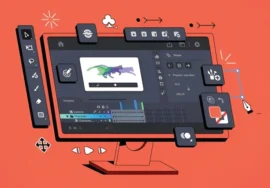
The Different 3D Design: A Comprehensive Guide
3D design has revolutionized the way we visualize and create products, environments, and experiences. With its ability to bring ideas to life in a tangible and immersive way, 3D design has become an indispensable tool for businesses, artists, and designers alike.
In this comprehensive guide, we will explore the different 3D designs, their applications, and the tools used to create them.
What is 3D Design?
The 3D design is creating three-dimensional digital models using specialized software. These models can be static or animated and can be used for a variety of purposes, such as product design, architectural visualization, video game development, and film production.
Types of 3D Design
- 3D Modeling
3D modeling is finding 3D designs. It involves creating 3D objects using polygons, curves, or other geometric primitives. 3D models can visualize products, environments, and characters.
Types of 3D Modeling:
- Polygon Modeling: This technique involves creating 3D models by connecting points (vertices) with lines (edges) to form polygons (faces). It is the most common of 3D modeling and is used for creating a wide range of objects, from simple shapes to complex characters.
- NURBS Modeling: NURBS (Non-Uniform Rational B-Spline) modeling is a mathematical technique used to create smooth, organic shapes. It is often used for creating complex curves and surfaces, such as those found in automotive design and industrial design.
- Subdivision Modeling: Subdivision modeling is a technique that starts with a simple low-polygon model and then subdivides the faces to create more detailed and complex shapes. It is often used for creating organic shapes, such as characters and creatures.
- 3D Animation
3D animation is bringing 3D models to life by creating appearing movement. It involves creating a series of frames, each with a different pose or position, and then playing them back in sequence to create a smooth animation.
Types of 3D Animation:
- Character Animation: This animation focuses on creating realistic or stylized characters and animating their movements. It is used in films, video games, and commercials.
- Object Animation: This animation focuses on animating objects, such as props, vehicles, and special effects. It is used in films, video games, and commercials.
- Motion Graphics: This animation uses motion graphics elements, such as text, shapes, and icons, to create appealing and informative animations. It is used in explainer videos, presentations, and advertising.
- 3D Rendering
3D rendering is creating realistic images from 3D models. It involves simulating the interaction of light with surfaces to create shadows, reflections, and other visual effects.
Types of 3D Rendering:
- Ray Tracing: Ray tracing is a correct rendering technique that simulates the path of light rays from a light source to the viewer’s eye. It produces realistic images but can be expensive.
- Restoration: restriction is a faster rendering technique that converts 3D models into 2D images by projecting them onto a screen. It is used for real-time rendering in video games and virtual reality.
- 3D Printing
3D printing is creating physical objects from digital 3D models. It involves adding layer upon layer of material to build up a 3D object.
Types of 3D Printing:
- Fused Deposition Modeling (FDM): This is the most common type of 3D printing, where a filament is melted and extruded layer by layer to create an object.
- Stereolithography (SLA): This technique uses a laser to cure liquid resin layer by layer, creating highly detailed and precise objects.
- Selective Laser Sintering (SLS): This technique uses a laser to sinner powdered material, layer by layer, to create objects with complex geometries.
Tools for 3D Design
There are many different software tools available for 3D design, each with its strengths and weaknesses. Some of the most popular tools include:
- 3D Modeling: Blender, Maya, 3ds Max, Cinema 4D, SketchUp
- 3D Animation: Blender, Maya, 3ds Max, Cinema 4D, Adobe After Effects
- 3D Rendering: Blender, V-Ray, Arnold, Octane Render
- 3D Printing: Cura, Simplify3D, PrusaSlicer
The Future of 3D Design: Emerging Trends and Innovations
As technology continues to advance, so too does the field of 3D design. Several emerging trends are poised to reshape the industry in the coming years:
1. Real-time Rendering:
- Enhanced Visuals: Real-time rendering techniques are enabling the creation of highly realistic and detailed 3D environments.
- Interactive Experiences: This technology is powering interactive experiences in video games, virtual reality, and augmented reality applications.
2. Artificial Intelligence and Machine Learning:
- Automated Design: AI-powered tools can automate repetitive tasks, such as texture mapping and rigging, freeing up designers to focus on creative aspects.
- Predictive Design: AI algorithms can analyze vast datasets to predict design trends and generate innovative concepts.
3. Virtual and Augmented Reality:
- Immersive Experiences: VR and AR technologies are transforming the way we interact with 3D content, offering immersive experiences in gaming, training, and design.
- Remote Collaboration: VR and AR can enable designers to collaborate remotely, regardless of their physical location.
4. Digital Twins:
- Real-World Simulations: Digital twins are virtual replicas of physical objects or systems. They can be used to simulate real-world scenarios, optimize performance, and make data-driven decisions.
- Predictive Maintenance: By analyzing data from digital twins, engineers can predict potential failures and implement preventive maintenance.
5. 3D Printing Advancements:
- Material Innovation: New materials and printing techniques are expanding the possibilities of 3D printing, enabling the creation of complex and functional objects.
- Personalized Products: 3D printing is making it possible to produce highly customized products tailored to individual needs and preferences.
Conclusion
The future of 3D design is bright, with exciting innovations on the horizon. By embracing these emerging trends, designers can push the boundaries of creativity and create truly groundbreaking experiences.
As 3D design continues to evolve, it will play an increasingly important role in shaping the world around us. From product design and architecture to entertainment and healthcare, 3D design is transforming industries and redefining the possibilities of human creativity.





